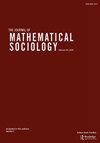A differential-equation-based model of the glass ceiling in career progression
IF 1.3
4区 社会学
Q3 MATHEMATICS, INTERDISCIPLINARY APPLICATIONS
引用次数: 4
Abstract
ABSTRACT We introduce a model based on Ordinary Differential Equations to describe how two mutually exclusive groups progress through a career hierarchy, whether in a single organization, or in an entire economic sector. The intended application is to gender imbalance at the top of the academic hierarchy in European Universities; however, the model is entirely generic and may be applied in other contexts also. Previous research on gender imbalance in European universities has focused on large-scale statistical studies. Our model represents a point of departure, as it is deterministic (i.e., based on Ordinary Differential Equations). The model requires a precise definition of the progression rates for the different groups through the hierarchy; these are key parameters governing the dynamics of career progression. The progression rate for each group can be decomposed into a product: the proportion of group members at a low level in the hierarchy who compete for promotion to the next level a given year, multiplied by the in-competition success rate for the group in question. Either of these two parameters can differ across the groups under consideration; this introduces a group asymmetry into the organization’s composition. We introduce a glass-ceiling index to summarize this asymmetry succinctly. Using case studies from the literature, we demonstrate how the mathematical framework can pinpoint the proximate cause of the glass ceiling in European academia.基于微分方程的职业发展玻璃天花板模型
摘要:我们引入了一个基于常微分方程的模型来描述两个相互排斥的群体如何在一个职业层次中发展,无论是在一个组织中,还是在整个经济部门中。预期的应用是针对欧洲大学最高学术层次的性别失衡;然而,该模型是完全通用的,也可以应用于其他上下文。此前关于欧洲大学性别失衡的研究主要集中在大规模的统计研究上。我们的模型代表了一个出发点,因为它是确定性的(即基于常微分方程)。该模型要求通过层次结构精确定义不同群体的进步率;这些都是决定职业发展动态的关键参数。每个小组的进步率可以分解为一个乘积:在给定的一年里,等级中处于较低级别的小组成员竞争晋升到下一级别的比例,乘以相关小组的竞争成功率。这两个参数中的任何一个都可能因所考虑的组而异;这在组织结构中引入了群体不对称性。我们引入了一个玻璃天花板指数来简洁地总结这种不对称性。通过文献中的案例研究,我们展示了数学框架如何准确定位欧洲学术界玻璃天花板的直接原因。
本文章由计算机程序翻译,如有差异,请以英文原文为准。
求助全文
约1分钟内获得全文
求助全文
来源期刊

Journal of Mathematical Sociology
数学-数学跨学科应用
CiteScore
2.90
自引率
10.00%
发文量
5
审稿时长
>12 weeks
期刊介绍:
The goal of the Journal of Mathematical Sociology is to publish models and mathematical techniques that would likely be useful to professional sociologists. The Journal also welcomes papers of mutual interest to social scientists and other social and behavioral scientists, as well as papers by non-social scientists that may encourage fruitful connections between sociology and other disciplines. Reviews of new or developing areas of mathematics and mathematical modeling that may have significant applications in sociology will also be considered.
The Journal of Mathematical Sociology is published in association with the International Network for Social Network Analysis, the Japanese Association for Mathematical Sociology, the Mathematical Sociology Section of the American Sociological Association, and the Methodology Section of the American Sociological Association.
 求助内容:
求助内容: 应助结果提醒方式:
应助结果提醒方式:


